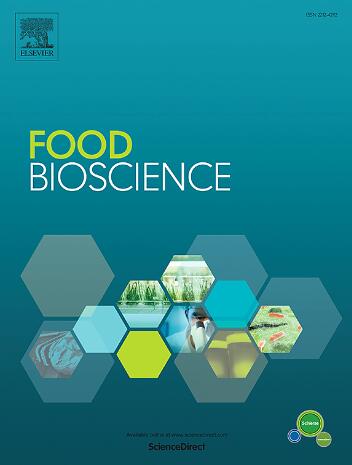Cordia dichotoma fruit mucilage and flaxseed oil nanoemulsion loaded bioactive film: Synergistic approach to enhance antimicrobial properties and bread shelf-life
IF 4.8
1区 农林科学
Q1 FOOD SCIENCE & TECHNOLOGY
引用次数: 0
Abstract
Recently, non-conventional sources of mucilage have gained significant attention due to their exceptional techno-functional properties and easy availability. This study aimed to utilize fruit mucilage (CDM) for fabricating bioactive films to evaluate the shelf-life of bread. For the development of nanoemulsion, different concentrations of flaxseed oil (1–5% w/w) were employed. Selection was carried out based on droplet size, encapsulation efficiency, and antimicrobial activity. The selected nanoemulsion (CDM-FO1) was subsequently used to develop CDM-based films with the incorporation of carboxymethyl cellulose (CMC) and sodium alginate (SA). Results revealed that the droplet size of the nanoemulsions was significantly increased from 101.25 ± 4.68 nm to 205.15 ± 7.14 nm with increasing flaxseed oil concentration. However, the addition of CMC and SA improved the tensile strength (13.97 ± 0.34 MPa) of the CDM-F11 film compared to control films CDM (6.98 ± 0.68 MPa) and CDM-FC (7.76 ± 1.65 MPa). The CDM-F11 film exhibited excellent barrier properties compared to the control film. The control film showed higher yeast and mold growth, starting at 0.84 ± 0.57 Log CFU/g on the 3rd day and increased to 3.12 ± 0.39 Log CFU/g by the 9th day. In contrast, the CDM-FC film demonstrated better antimicrobial properties, with microbial growth at 0.52 ± 0.39 Log CFU/g on the 3rd day and 2.84 ± 0.38 Log CFU/g on the 9th day. Overall, CDM film loaded with flaxseed oil nanoemulsion can be effectively used as a sustainable food packaging material with enhanced antimicrobial efficiency for bread preservation.绶带果粘液和亚麻籽油纳米乳液负载生物活性薄膜:提高抗菌性能和面包保质期的协同方法
近来,非传统来源的粘液因其特殊的技术功能特性和易于获得而备受关注。本研究旨在利用水果粘液(CDM)制作生物活性薄膜,以评估面包的保质期。为开发纳米乳液,采用了不同浓度的亚麻籽油(1-5% w/w)。选择的依据是液滴大小、封装效率和抗菌活性。选定的纳米乳液(CDM-FO1)随后被用于开发基于 CDM 的薄膜,其中加入了羧甲基纤维素(CMC)和海藻酸钠(SA)。结果显示,随着亚麻籽油浓度的增加,纳米乳液的液滴尺寸从 101.25 ± 4.68 nm 显著增加到 205.15 ± 7.14 nm。然而,与对照薄膜 CDM(6.98 ± 0.68 MPa)和 CDM-FC (7.76 ± 1.65 MPa)相比,添加 CMC 和 SA 提高了 CDM-F11 薄膜的拉伸强度(13.97 ± 0.34 MPa)。与对照薄膜相比,CDM-F11 薄膜具有出色的阻隔性能。对照薄膜显示出较高的酵母和霉菌生长率,从第 3 天的 0.84 ± 0.57 Log CFU/g,增加到第 9 天的 3.12 ± 0.39 Log CFU/g。相比之下,CDM-FC 薄膜表现出更好的抗菌性能,第 3 天的微生物生长量为 0.52 ± 0.39 Log CFU/g,第 9 天为 2.84 ± 0.38 Log CFU/g。总之,添加亚麻籽油纳米乳液的 CDM 薄膜可作为一种可持续食品包装材料,有效提高面包的抗菌效率。
本文章由计算机程序翻译,如有差异,请以英文原文为准。
求助全文
约1分钟内获得全文
求助全文
来源期刊

Food Bioscience
Biochemistry, Genetics and Molecular Biology-Biochemistry
CiteScore
6.40
自引率
5.80%
发文量
671
审稿时长
27 days
期刊介绍:
Food Bioscience is a peer-reviewed journal that aims to provide a forum for recent developments in the field of bio-related food research. The journal focuses on both fundamental and applied research worldwide, with special attention to ethnic and cultural aspects of food bioresearch.
 求助内容:
求助内容: 应助结果提醒方式:
应助结果提醒方式:


